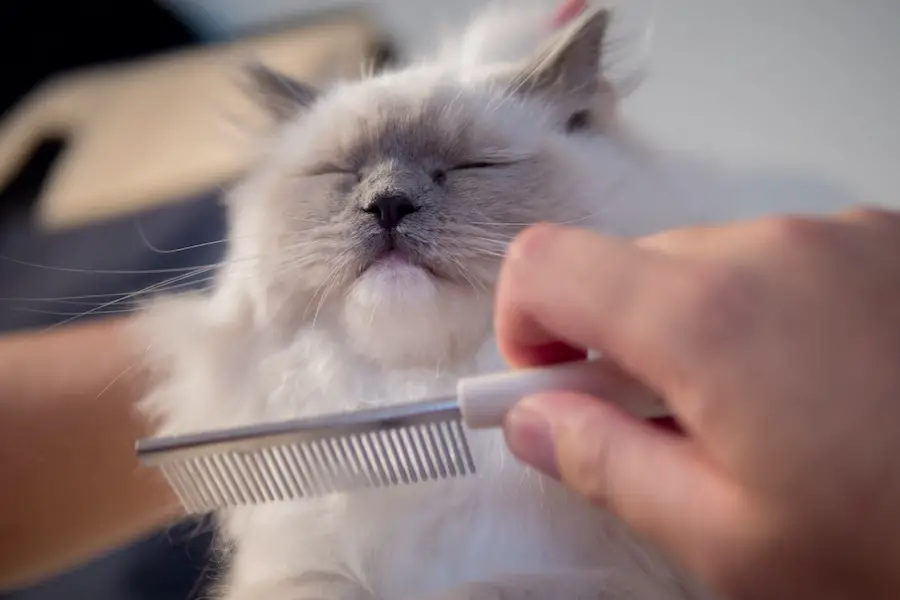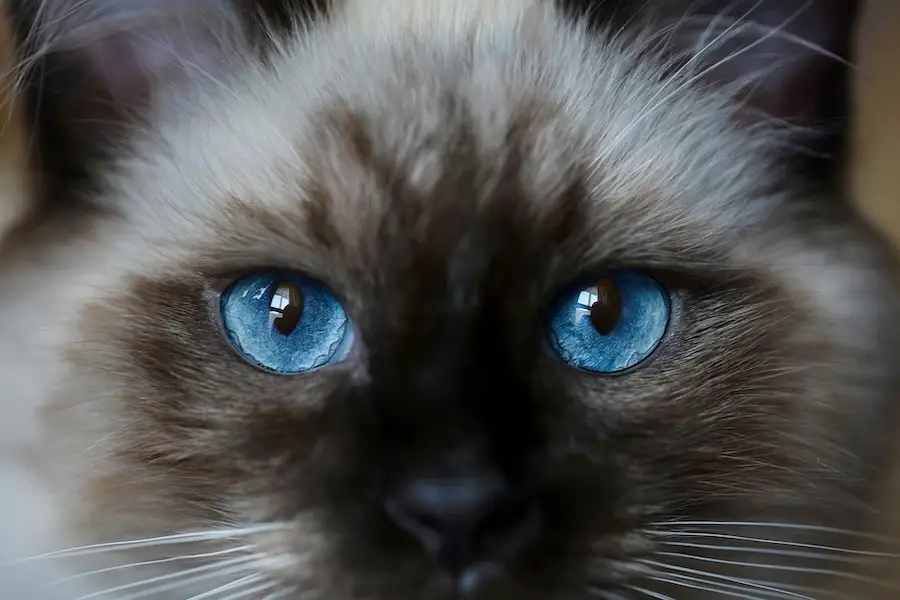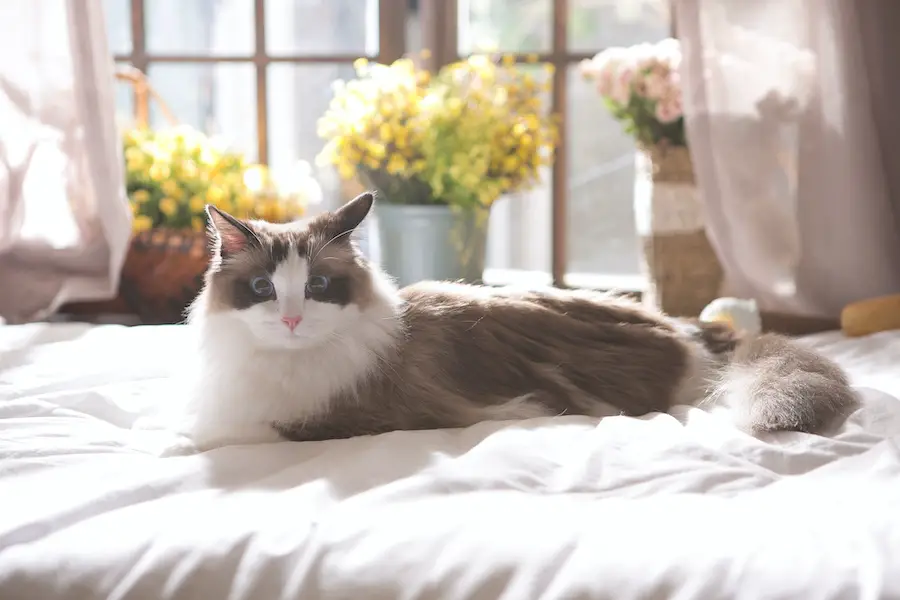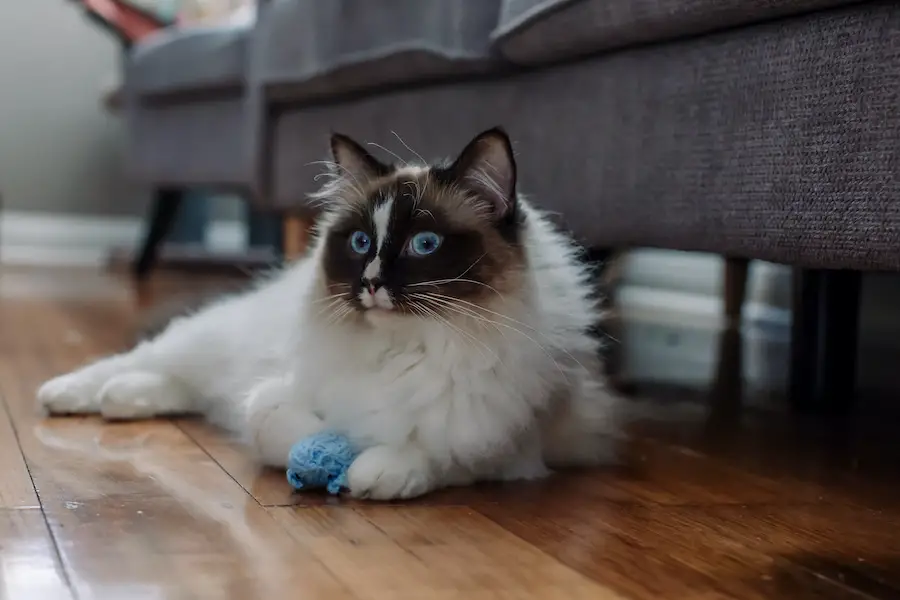If you’re looking for a unique breed of cat, the Ragdoll cat is worth considering. These cats are known for their docile personality and striking blue eyes. They can be prone to medical conditions, so it’s important to do your research before bringing one into your home. In this post, we will provide some fun facts about Ragdoll Cats, as well as tips on how to care for them.
The Origin of the Ragdoll Cat
The Ragdoll Cat is a relatively new breed, having been developed in the 1960s. The foundation cats for the Ragdoll were a seal mitted female named Josephine and a black and white bicolor male named Daddy Warbucks. These two cats were bred by Ann Baker, who then went on to develop the Ragdoll breed. Baker created the Ragdoll by crossing several different breeds, including the Birman, Burmese, and Persian. The resulting cats were larger than average with a docile personality and a propensity to go limp when picked up (hence the name “Ragdoll”). Baker kept tight control over the breeding of her Ragdolls, which resulted in some inbreeding and genetic defects. In the 1980s, a group of breeders broke away from Baker and began working to improve the health and vigor of the Ragdoll. Today, Ragdolls are recognized by all major cat registries and are considered a healthy, hearty breed.
While Ragdolls are known for being gentle and loving cats, they do have some specific care requirements. Ragdolls are a medium to large breed, so they need plenty of space to run and play. They also require regular grooming, as their long fur is prone to tangles and mats. Ragdolls are indoor cats, so they should always be kept indoors to protect them from predators and traffic. Ragdolls are also relatively inactive cats, so they don’t require a lot of exercise. However, it’s important to provide them with some toys and climbing opportunities to keep them mentally stimulated.
Breed Quick Facts
Lifespan
Up to 15 Years
Size
Females: 10-15 lbs
Males: 15-20 lbs
Origin
Riverside, California
Personality Traits of Ragdoll Cats
Ragdoll cats are known for their easygoing, affectionate personalities. They love to be around people and will often follow their owner from room to room. Ragdolls also enjoy being held and cuddled, and they typically don’t mind being carried around or even dressed up in clothes. This breed is not particularly active, preferring instead to lounge and relax. But that doesn’t mean Ragdolls don’t like to play – they just tend to do so in a more laid-back way than some of the other breeds. When it comes to interacting with other pets, Ragdolls usually do well with dogs and other cats. So if you’re looking for a relaxed and loving feline friend, a Ragdoll might be the perfect choice for you.
Physical Traits of Ragdoll Cats
Ragdoll cats have a very distinct appearance. They are large cats with long bodies and thick fur. Their fur is usually white or cream-colored, and “pointed” with darker fur on the ears, face and tail. Ragdoll cats also have striking blue eyes. Ragdoll cats are known for their laid-back, relaxed personalities. Ragdolls are one of the largest breeds of domestic cat, and they can weigh up to 20 pounds.
Medical Conditions Common to Ragdoll Cats
Medical conditions that can affect ragdoll cats include heart disease, hip dysplasia, diabetes, and thyroid disorders. If you have a Ragdoll cat, it’s important to be aware of these conditions and to take your cat to the vet for regular checkups.
While they are generally healthy cats, Ragdolls can be prone to certain medical conditions. These include heart disease, kidney disease, hip dysplasia, diabetes, and thyroid disorders. It’s important to work with a reputable breeder who can provide health clearances for the parents of your kitten.
Ragdoll cats also have a higher than average risk of developing cancer. However, with proper care and treatment, most Ragdolls live long, happy lives. If you think your cat may be suffering from any of these conditions, please contact your veterinarian immediately. Early diagnosis and treatment are often critical for the best possible outcome.
How to Care for a Ragdoll Cat
Ragdoll cats are one of the most popular breeds of house cats and for good reason. They’re gentle, loving, and make great companions. But like all pets, they require some care and attention to keep them healthy and happy. Here are a few tips on how to care for your Ragdoll cat.
First, it’s important to keep their coat clean and brushed. Ragdolls have long, thick fur that can easily become matted if not cared for properly. Be sure to brush them at least once a week with a soft-bristled brush, paying special attention to their belly and legs where the fur is longest.
Second, Ragdolls love to play Keep them entertained with plenty of toys, and give them plenty of space to run and explore. A scratching post is also a good idea to keep their claws healthy and help prevent furniture from getting scratched up.
Finally, like all cats, Ragdolls need regular veterinary care. Be sure to take them in for yearly checkups and vaccinations, and watch for any signs of illness or injury. With a little love and care, your Ragdoll cat will be a loyal friend for years to come.
How to Groom a Ragdoll Cat
Ragdoll cats are beautiful, gentle creatures. However, they do require some special care when it comes to grooming. Here are some tips on how to groom your Ragdoll cat:
- First, you will need to brush your Ragdoll’s fur. This should be done at least once a week, and more often if your cat starts to shed heavily. A good quality bristle brush or comb will work well.
- You will also need to trim your Ragdoll’s nails regularly. This should be done every two weeks or so, using a sharp nail trimmer designed for cats.
- Finally, don’t forget to give your Ragdoll a bath occasionally! This is not typically necessary more than once every few months, but some cats enjoy it more often. Be sure to use a cat-specific shampoo, and avoid getting water in your Ragdoll’s ears or eyes.
By following these simple tips, you can keep your Ragdoll cat looking and feeling her best! And if you have any questions about grooming, be sure to ask your veterinarian for advice.
Nutrition Requirements for Ragdoll Cats
There are a few things to keep in mind when it comes to the nutrition requirements of your Ragdoll cat. First of all, they require a high protein diet to maintain their muscle mass. Secondly, they need a good balance of omega-three and six fatty acids for healthy skin and coat. Lastly, be sure to give them plenty of water to keep them hydrated. By following these simple tips, you can be sure that your Ragdoll cat will stay healthy and happy for years to come.

Ragdoll Cats: Play and Exercise Requirements
Ragdoll cats are known for being laid back, but that doesn’t mean they don’t need exercise. Just like any other cat breed, Ragdolls need a good amount of play and exercise to stay healthy and happy.
There are a few different ways you can provide your Ragdoll with the exercise they need. One way is to invest in some good cat toys, like a scratching post, climbing tree, or even a simple ping pong ball. You can also create an indoor obstacle course for your cat using household items. Another option is to take your Ragdoll for walks on a leash – yes, that’s right, you can walk your Ragdoll just like you would a dog!
Whatever method you choose, just make sure that your Ragdoll gets the exercise they need to stay healthy and happy. They’ll thank you for it in purrs and cuddles.
Ragdoll Cat Behavior
Ragdoll cats are known for their docile and placid temperament. They are affectionate, gentle, and loving animals that enjoy being with their humans. Ragdolls are also very intelligent cats and can be taught tricks and commands.
While Ragdolls have many wonderful qualities, they do require some special care. Because they are so laid back, they are not the best at grooming themselves and will need help to keep their coat clean and free of mats. Ragdolls also tend to become overweight, so it is important to feed them a healthy diet and give them plenty of exercise.
Overall, Ragdoll cats make wonderful pets for people who are looking for a relaxed, loving companion. If you are considering adding a Ragdoll to your family, be sure to do your research. With proper care and attention, your Ragdoll will bring you years of joy!
Do you have a Ragdoll cat? What tips do you have for keeping them healthy and happy? Let us know in the comments below!


